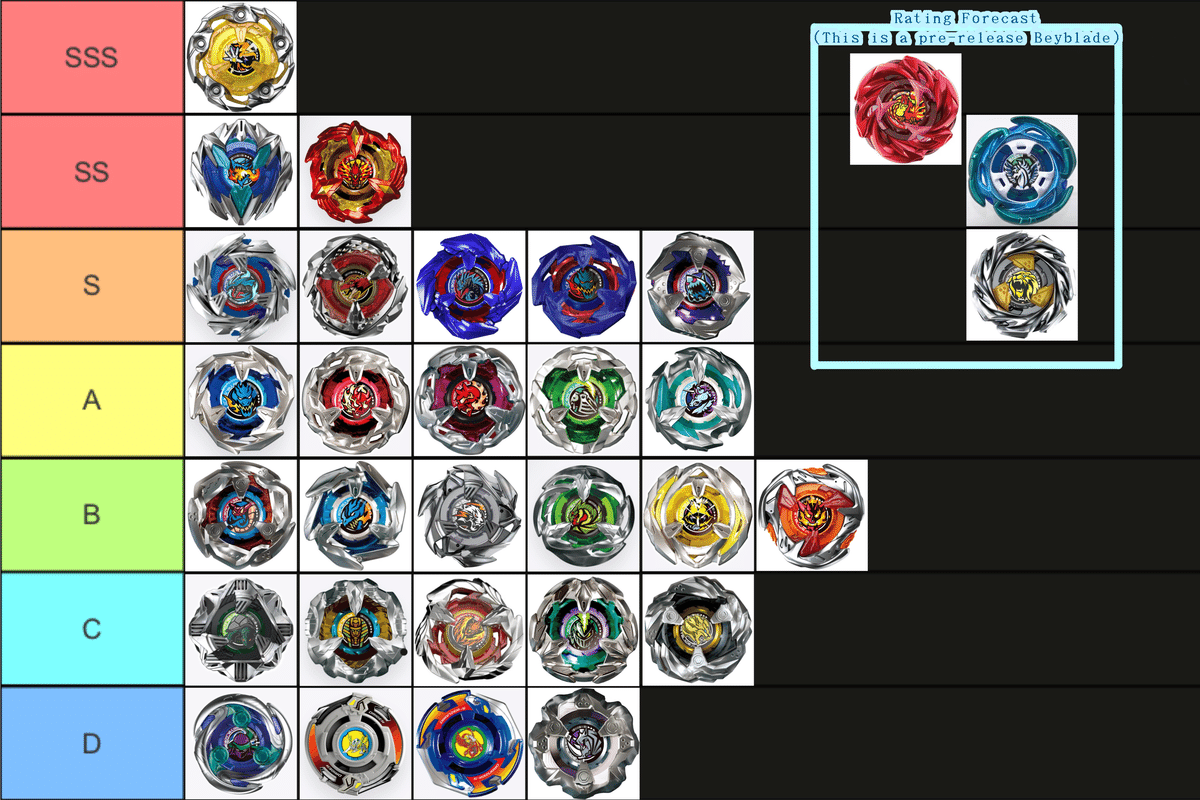
Beyblade X Tier Table
※本記事は全編英語です。
下記ポストの翻訳記事となっておりますので、そちらをご参照ください!
【簡易版ティア表】
— ジーク@『ベイブレードX ティア表』の人 (@XVMax_Siegbey) July 24, 2024
7月4週
大阪G1大会から1週間経ち、各所大会データもある程度収集出来たので更新してみました。
更に、今回からランクを5→7段階に細分化してみました。
①SS〜A→SSS〜A
②B、C→B〜D
に分けたイメージです。
※右枠内の3機は個人的な予想(願望込)です。#ベイブレードX https://t.co/SjUHPE7sQw pic.twitter.com/Ylv7ZeBP82
Hello.
I am Sieg, a blader from Japan.
I have made some changes to the latest Beyblade X Tier Chart that I have published on X (formerly Twitter).
This article is a hasty English translation of the Beyblade X Tier Chart, with an explanation and translation of the criteria.
Please read to the end if you like.
■Apology
This article is written by me, a Japanese person.
Therefore, there may be some ambiguity in the translation,
・This is a tier table based on the data of competitions in Japan and my own experience.
・Therefore, there may be ambiguous parts in the translation.
Please understand the above in advance.
If you have any questions, please contact X's account ( @XVMax_siegbey ).
I will be happy to be of help to braiders around the world.
Please have a look!
○Tier table

○Judgment Criteria
■SSS: Unquestionably the top environment
Adoption rate:★★★★★
Strength:★★★★★
A blade that must be counteracted, including mirror assumptions.
It is stable and strong no matter who uses it, but the more it wins, the more mirror matches it has to face, especially the overall strength of the bladers.
(In that sense, it is difficult to win out.)
■SS: Top tier of the environment
Adoption rate:★★★★☆
Strength:★★★★★
A must-have blade that is often used in 3on3 and other 1-bays, and although its adoption rate is lower than that of SSS, it can win out if it has a solid modification and strategy (concept).
Naturally, its win rate and point efficiency(*) are high even against S and below.
*Points efficiency: Calculated as the average of scores (-3 to +3) in one battle.
■S:Within the 3on3 adoption range
Adoption rate:★★★★☆
Strength:★★★★☆
This blade has a lower adoption rate than SS and above, but many types exist and its stand-alone performance is high.
Since then, preferences vary from blader to blader, but it is often seen in 3on3.
A: Adoption rate is low.
Adoption rate:★★★☆☆
Strength:★★★☆☆
Although highly versatile, the deck adoption rate is low compared to S and above. However, it is often used in 3-on-3 decks with pinpoint countermeasures or concepts.
B, C, D: Rarely seen.
B
Adoption Rate:★★☆☆☆
Strength:★★★☆☆
C
Adoption rate:★★☆☆☆
Strength:★★☆☆☆
D
Adoption Rate:★☆☆☆☆
Strength:★★☆☆☆
There are many blades that are upwardly compatible in terms of power, shape, weight, and other factors.
It is sometimes used as a "pinpoint countermeasure" by taking advantage of its features.
--------------------
Difference between B and D
→Blades that did not make it into the "A" category are ranked according to their versatility and win rate.
--------------------
いいなと思ったら応援しよう!

